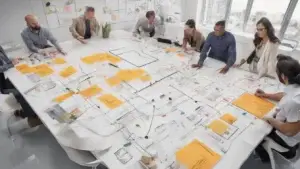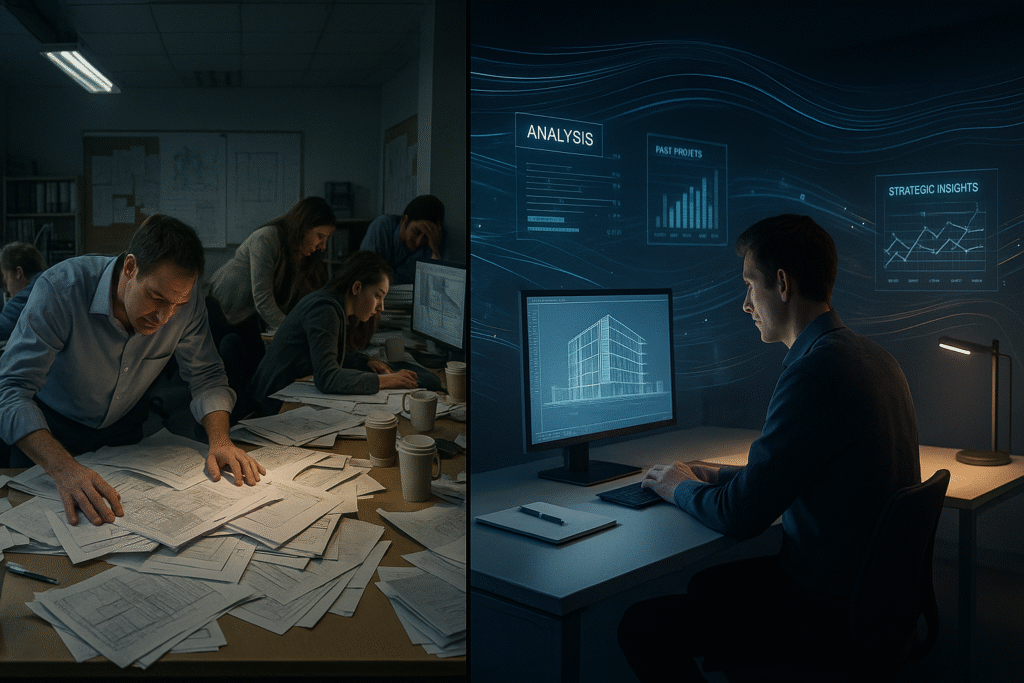

Something shifted in our local market about 18 months ago.
A mid-sized firm – let’s call them Studio 47 – started showing up everywhere. Healthcare RFPs we thought we had locked. Educational projects they’d never pursued before. Large-scale commercial work that should’ve been beyond their capacity.
At first, I assumed they’d gone on a hiring spree or merged with another firm. Neither was true.
Last month, I finally understood what happened. And it’s changing how I think about competitive advantage.
I started tracking win rates across our market. The data told a story I didn’t expect:
Studio 47 wasn’t just winning more. They were winning differently:
However, what really caught my attention was that their proposals had evolved. They weren’t just listing credentials anymore. They were demonstrating impossibly deep understanding of each client’s specific challenges.
I had to know how.
Through a mutual connection, I got permission to observe Studio 47’s proposal process. What I saw challenged every assumption I had about RFP responses.
Thursday, 4:47 PM: Healthcare RFP hits their inbox. $12M behavioral health facility. 14 days to respond.
In most firms, this triggers the familiar panic. Not here.
Within 30 minutes, their system had:
But that wasn’t the impressive part.
By 6 PM, their healthcare principal’s digital twin had drafted initial win themes that sounded exactly like her. Not templates. Not boilerplate. Authentic strategic insights based on 20 years of behavioral health experience.
“Watch this,” their marketing director said. She prompted the system: “What unique challenges might this client face that they haven’t articulated in the RFP?”
The response was sophisticated: Integration with existing mental health programs, staffing challenges specific to their rural location, state funding mechanisms that would affect phasing. Details no generic AI could know.
By Friday morning, they had a first draft. A good one.
Here’s what fascinated me most: They weren’t working harder. They were working with amplified intelligence.
I talked with their proposal team. “Before, we’d spend 80% of our time hunting for information and assembling content,” one coordinator told me. “Now we spend 80% of our time on strategy and refinement. It’s a completely different game.”
Their win rate improvement suddenly made sense. When you can focus most of your effort on understanding the client and crafting the perfect approach – rather than scrambling to assemble basic content – quality jumps dramatically.
But there’s a darker side to this story for traditional firms.
I’ve been analyzing RFP responses across multiple markets now. The gap between AI-enabled firms and traditional ones isn’t just widening – it’s accelerating.
Every proposal a digitally-enhanced firm wins feeds their system more intelligence:
Their digital twins not only maintain this advantage but also compound it with every submission.
Meanwhile, traditional firms are still relying on whoever’s available that week. Still searching through old proposals for that perfect project description. Still hoping experience and effort overcome process and intelligence.
I’ve done the math. It’s not sustainable.
Last week, I moderated a panel on business development. I asked the audience: “How many of you have lost an RFP to a firm you didn’t consider serious competition two years ago?”
Nearly every hand went up.
Then I asked: “How many of you know exactly why you lost?”
Most hands went down.
Here’s the brutal truth I’m seeing: The firms winning with AI assistance aren’t advertising it. They’re quietly dominating while their competitors wonder what happened.
One principal told me something that stuck: “We used to compete on experience and relationships. Now we compete on experience, relationships, AND the ability to deploy those assets intelligently at scale. Guess which firms are winning?”
Try this exercise: Pull your last five RFP responses. For each one, document:
Now, calculate the true cost. Include the opportunity cost of what those people couldn’t do while scrambling on proposals.
One firm I worked with discovered they were spending $47,000 in labor per proposal, with an 18% win rate. That’s $260,000 in cost per win. Unsustainable.
The firms using AI-powered systems? They’re spending 70% less time with 45% win rates. That math creates competitive advantages that compound monthly.
Here’s what I keep asking myself: If your competitors could respond to three times more opportunities with higher-quality proposals in less time, how long before they own your market?
This isn’t a future threat. It’s happening now.
I’ve seen three firms transform their RFP response process in the last year. Each one told me the same thing: “We can’t imagine going back to the old way.”
One marketing director put it perfectly: “It’s like we were trying to win a Formula 1 race with a really nice bicycle. Now we have a race car. So do our competitors who get this.”
The firms still on bicycles? They’re wondering why they keep losing.
I’m tracking something interesting: The window for competitive parity is closing. Fast.
Early adopters are building insurmountable advantages. Every month, AI-enhanced proposals contribute to their intelligence base. Every win funds more innovation. Every efficiency gain allows more market coverage.
The question isn’t whether AI will transform RFP responses. It’s whether you’ll be using it or competing against it.
What’s your take on this? Have you noticed certain firms suddenly winning more than their “fair share”? I’d love to hear what patterns you’re seeing…
Next week, I’ll share something that might be even more uncomfortable – why the timeline to AGI means these current advantages are just the beginning. The firms building AI infrastructure now aren’t just winning today’s game; they’re positioning for a completely different sport.
I spent 40+ years perfecting traditional proposal strategies. What I’m seeing now makes those approaches feel like bringing a knife to a gunfight. The competitive landscape hasn’t just shifted – it’s split into two different leagues.
If you’re curious about what these AI-enabled firms are actually doing differently, connect with me. The specific tactics might surprise you.
Share this post: